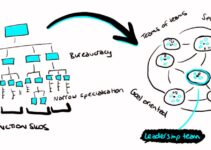Change management is a systematic method of managing and implementing change within and outside the organization. It comprises various processes from start to end like planning, organizing, implementing, unifying, guiding employees, taking mandatory steps, evaluating, and making sure that everything has gone as planned and implemented.
Organizational change is a bit difficult task, and it requires a high level of collaboration and cooperation among various independent units and departments of the company. The critical task is establishing a well-devised framework that makes sure that transition and transformation go as planned and minimize disruption.
Some of the key steps in implementing change management are as follows;
- What change management means to the company, defining it
- Choosing team members for the change management
- Recognizing management that is sponsoring change, and earning their confidence and commitment
- Devising change execution and implementation plan along with measuring metrics
- Executing the change step-by-step if it is convenient
- Gathering and analyzing the data
- Measuring and quantifying gaps and understanding resistance
- Upgrading the plan and implementing it back to the steps
Levels of Change Management
The change management plan allows businesses and companies to make their transition phase smoother. Implementing the change without having a proper plan on how they would report, monitor, and implement the work, would most likely fail. Change management allows you to have control over various processes, especially those processes that are expensive investments and implementation.
Some of the different levels of change management are as follows;
Transformational or Organizational Change
It deals with such CM projects and ventures that have a large scope and large scale. Often, the transition and transformation within the organization are dramatic like; going through digital transformation, introducing a new product or service, or hierarchical change.
Gradual or Adaptive Change
The scope and scale of such change projects are small like small changes in the workflows, strategies, plans, processes, and products or services. It comprises upgrading the work-from-home strategy, recruiting new employees to deal with current issues, and implementing new tools and software.
Individual Change Management
It comprises such projects that help people to grow, improve, and achieve their individual goals and objectives. Often, it involves learning new skills or expertise.
Types of Change Management
Some of the main types of changes management are as follows;
Transformational or Paradigm Change
It comprises changes in the company’s values and beliefs, and becoming the new norm. For instance, when the company is transforming from a synchronous communication system to a hybrid model; then it deals with both synchronous and asynchronous communication models.
Pendulum or Transitional Change
Just like the pendulum swinging from one point to another; transforming from one state of work to another completely different extreme. For instance, we have recently observed the transition phase from 100% working in the office to 100% remote working or work-from-home
Incremental or Developmental Change
It is a type that implements the change gradually, rather than sudden shift like toppling down the existing and upgrading it with the latest technology.
Exceptional Change
It comprises isolation and fragmented events that would change the experiences of an individual, but they won’t impact various areas of their lives significantly. For instance, a change in the email address or a person’s name would require some paperwork in the HR office, but it won’t impact the person’s job, role, and responsibilities.
Benefits of Change Management
Some of the key benefits and advantages of change management are as follows;
- Allows organizational projects to succeed and achieve ROI (return on investment) in their transitional projects and ventures
- Empower employees and people within the organization to adapt to change and become a productive member
- Dealing with various elements of the change phase like technology, processes, and employees
- Developing strategies and plans to implement the change effectively and applying it to different transformational projects across the organization
- Establishing goals and objectives for the change project, and setting up metrics to evaluate their performance
- Actively fighting with such elements that are resistant to change
Principles of Change Management
Some of the key principles and models of change management that help managers to implement changes within the organization are as follows;
McKinsey 7-S
Tom Peters, Waterman Jr., and Robert H were business consultants and they developed a model to analyze seven key factors that would impact the change. They are as follows;
- Structure
- Strategy
- Shared Values
- Skills
- Staff
- Styles
- Systems
Lewin’s 3-Step Change Model
Kurt Lewin, a psychologist developed a three-step model and a framework, and it also goes by the name of Unfreeze-change-refreeze. They are as follows;
- Unfreeze
- Change
- Refreeze
Kotter’s 8-Step Change Model
John Kotter, a Harvard University professor developed an eight-step change model, and it comprises following steps;
- Creating and developing a sense of urgency
- Establishing a Guiding Coalition
- Developing a strategic plan and taking an initiative
- Enlisting Volunteer army
- Taking action by eliminating barriers
- Gaining Win in the short term
- Sustaining Acceleration
- Institute change
ITIL (IT Infrastructure Library)
ITIL provides guidelines and tips to manage and organize change in the infrastructure and operations of IT. Axelos owns this model; it is a joint venture between the UK cabinet office and capita.
Bridges Transition Model
The focus of this model is how people and employees adjust themselves to the change. It comprises three stages;
- Letting go stage
- Confusion and uncertain stage
- Acceptance stage
William Bridges developed this model and he sometimes compares his model with Kubler Ross’ model of grief its stages are; denial, anger, bargaining, depression, and acceptance.
ADKAR Model
ADKAR model comprises of following five stages;
- Awareness
- Desire
- Knowledge
- Ability
- Reinforcement
Tips for Effective Change Management
Some of the key tips for implementing the change management effects are as follows;
- Focus on the change and finding the opportunities urgently
- Dividing the change project into smaller steps, it becomes easier for the team to adapt
- Dealing with resistance and hesitant of employees to change
- Training employees
- Selecting the change leader that would motivate the employees
- Getting feedback and making improvements
Conclusion: What is Change Management? Types, Principles, Benefits
After an in-depth study of what is change management; its various types, levels, principles, benefits, and tips; we have realized that change management is significant for the growth of the organization. If you’re learning about changes management, then you should keep in mind the abovementioned tips and guidelines.
Ahsan is an accomplished researcher and has a deep insight in worldly life affairs. He goes Live 3 days a week on various social media platforms. Other than research writing, he’s a very interesting person.


